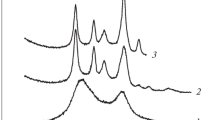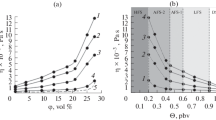Abstract
The relationships of the formation of a three-dimensional conducting network from carbon black particles in melts of polyethylene, polystyrene, and polyethylene–polydimethylsiloxane and polyethylene–polystyrene blends after the action of shear strain were studied. Such network in the polymer blends is formed faster and in a shorter time than in the individual polymer melts. This is caused by the fact that the major fraction of carbon black is concentrated in one of the polymeric components and at the polymer interface. In addition, it is highly likely that rapid formation of the network of filler particles in polymer blends is favored by higher rate of directional motion of carbon black particles to the polymer interface, compared to disordered Brownian motion of these particles in the bulk. The relationships obtained create prerequisites for the development of conducting polymer materials whose electrical conductivity is less sensitive to processing conditions.



Similar content being viewed by others
REFERENCES
Taherian, R. and Kausar, A., Electrical Conductivity in Polymer-based Composites: Experiments, Modelling and Application, Elsevier, 2018.
Zaikin, A.E. and Vassunov, A.V., Vestn. Kazansk. Tekhnol. Univ., 2002, nos. 1–2, pp. 115–121.
Wu, G., Asai, S., Zhang, C., Miura, T., and Sumita, M., J. Appl. Phys., 2000, vol. 88, no. 3, pp. 1480–1487. https://doi.org/10.1063/1.373843
Zaikin, A.E., Zharinova, E.A., and Bikmullin, R.S., Polym. Sci., Ser. A, 2007, vol. 49, no. 3, pp. 328–336. https://doi.org/10.1134/S0965545X07030145
Zhang, Q., Wang, J., Yu, J., and Guo, Z.-X., Soft Matter, 2017, vol. 13, no. 18, pp. 3431–3439. https://doi.org/10.1039/C7SM00346C
Wu, S., J. Macromol. Sci., Part C, 1974, vol. 10, no. 1, pp. 1–73. https://doi.org/10.1080/15321797408080004
Binks, B.P. and Horozov, T.S., Colloidal Particles at Liquid Interfaces, Cambridge: Cambridge Univ. Press, 2000.
Sumita, M., Sakata, K., Asai, S., Miyasaka, K., and Nakagawa, H., Polym. Bull., 1991, vol. 25, no. 2, pp. 265–271. https://doi.org/10.1007/BF00310802
Plattier, J., Benyahia, L., Dorget, M., Niepceron, F., and Tassin, J.-F., Polymer, 2015, vol. 59, pp. 260–269. https://doi.org/10.1016/j.polymer.2014.12.044
Author information
Authors and Affiliations
Corresponding author
Ethics declarations
The authors declare that they have no conflict of interest.
Additional information
Translated from Zhurnal Prikladnoi Khimii, No. 7, pp. 904–908, January, 2021 https://doi.org/10.31857/S0044461821070124
Rights and permissions
About this article
Cite this article
Zaikin, A.E., Akhmetov, A.R. Formation of the Percolation Network by Carbon Black Particles in Blends of Incompatible Polymers under the Conditions of Shear Strain of the Melt. Russ J Appl Chem 94, 954–958 (2021). https://doi.org/10.1134/S1070427221070132
Received:
Revised:
Accepted:
Published:
Issue Date:
DOI: https://doi.org/10.1134/S1070427221070132




